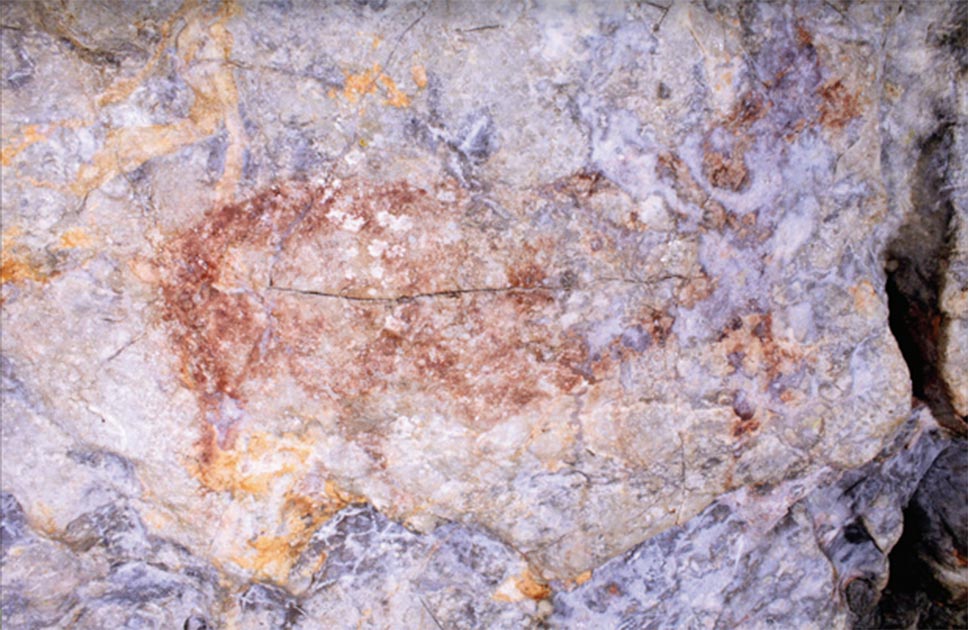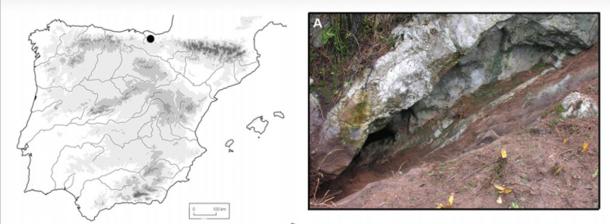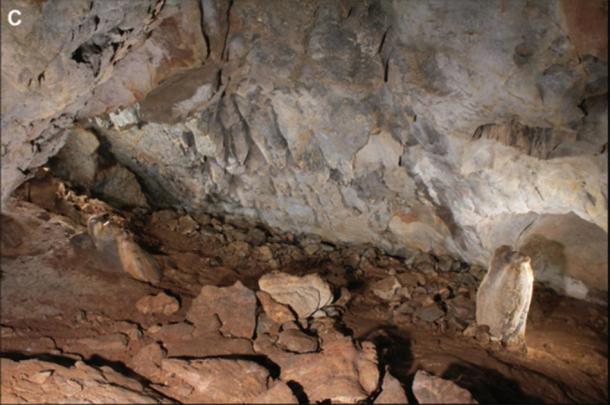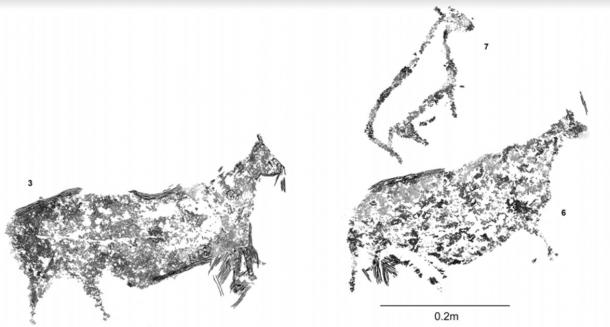Research — Ruth Schuster, Haaretz, 12th March 2020
Very faded but finally noticed, the Basque region cave paintings show that distinct Paleolithic cultures survived cheek by jowl for millennia
Spain and France are hot spots of Paleolithic sites and art going back thousands and tens of thousands of years. On the other hand, the enigmatic Basque Country, which straddles the border between those two countries, was considered to be a graphic void. There were plenty of Stone Age sites there, where prehistoric peoples had clearly lived, but art had only been found in a measly six caves.
Thus, the full extent of ancient art in Basque Country just hadn’t been noticed1, argue authors Blanca Ochoa of the Universidad del Pais Vasco in Spain, with fellow archaeologists Marcos García-Diez and Irene Vigiola-Toña, in a recent paper in the journal Antiquity, describing in exquisite detail the newly discovered parietal pictures in Danbolinzulo Cave.
....
The fact that differing artistic styles were found among peoples that did rub shoulders with one another throughout thousands of years is a mystery, Ochoa says. “We think maybe that they have different cultural backgrounds. But we don’t know why they chose to have two very distinct styles,” she adds.
If we think about it, “modern” art in Europe, Central Asia, the Near East, India and the Far East all maintained substantive differences over long centuries, during which the cultures were very much in touch. So that could make sense.
1.In fact in recent years archaeologists equipped with sophisticated methodological means have discovered 17 previously unnoticed sites in the Basque region that have art from the late Palaeolithic period, some of which may be as old as 40,000 years. The finds debunk the void theory and bring the total known Stone Age graphic sites there to 23, Ochoa confirms in conversation with Haaretz.
Ochoa, Blanca, Marcos García-Diez, and Irene Vigiola-Toña. “Filling the Void: a New Palaeolithic Cave Art Site at Danbolinzulo in the Basque Country.” Antiquity 94, no. 373 (2020): 27–43.
doi:10.15184/aqy.2019.236
Northern Spain has a high density of Upper Palaeolithic cave art sites. Until recently, however, few such sites have been reported from the Basque Country, which has been considered to be a ‘void’ in the distribution of parietal art. Now, new discoveries at Danbolinzulo Cave reveal a different situation. The graphic homogeneity of the motifs, which comprise five ibex, two horses and a possible anthropomorph, along with several unidentified figures, strongly suggests a pre-Magdalenian (>20 000 cal BP) date for the art. Here, Danbolinzulo is interpreted in its wider context as occupying a pivotal position between Cantabrian-Iberian and Fre
Thursday, March 12, 2020
Ancient Art Found in Basque Country Changes Understanding of Prehistoric Society

The crude red outline and interior color wash is typical of pre-Magdalenian Paleolithic art, over 20,000 years oldB. Ochoa / M. García-Diez / I. Vigiola
Spain and France are hot spots of Paleolithic sites and art going back thousands and tens of thousands of years. On the other hand, the enigmatic Basque Country, which straddles the border between those two countries, was considered to be a graphic void. There were plenty of Stone Age sites there, where prehistoric peoples had clearly lived, but art had only been found in a measly six caves.
Thus, the full extent of ancient art in Basque Country just hadn’t been noticed, argue authors Blanca Ochoa of the Universidad del Pais Vasco in Spain, with fellow archaeologists Marcos García-Diez and Irene Vigiola-Toña, in a recent paper in the journal Antiquity, describing in exquisite detail the newly discovered parietal pictures in Danbolinzulo Cave.

13 MARCH, 2020 - ASHLEY COWIE
40,000-Year-Old Cave Art Fills Basque Country Void
New cave paintings discovered in northern Spain date back 40,000 years and demonstrating two distinct artistic styles.
According to a new paper published by lead author Blanca Ochoa, in journal Antiquity, the discovery of 17 news caves in the Basque region between Spain and France adds greatly to what is known about ancient artistic tradition as only six were previously known which display ancient Paleolithic art .
Researchers from the University of the Basque Country examined 23 sites with prehistoric art in northern Spain and the new study says they are from the pre-Magdalenian period, from between 20,000 and 40,000 years ago and much “more prolific than first thought.”

Entrance to the Danbolinzulo cave, where one of the discoveries was made.
(Blanca Ochoa et al. / Antiquity Publications Ltd )
Painting A Picture Of An Ancient Territorial Border
According to the team of researchers, the most important new discovery is the “Danbolinzulo cave,” on the slopes of Mount Ertxina near the town of Zestoa in northern Spain which features what they call a “homogeneity of the motifs.” Through the faded orange and brown paint on the rock walls several unidentified figures are represented amidst “five ibex, two horses and a possible anthropomorph (ancient stylized representation of a human being.)
The drawings were executed as far back as far as 40,000 years ago and they bridge two distinctly different artistic traditions which the researchers describe as “a pivotal position” between Cantabrian-Iberian and French/Continental art styles. Another pre-Magdalenian cave near to Danbolinzulo was found to display French/Continental art styles, which again suggests the presence of an ancient cultural border.

Location of the panels in the Danbolinzulo cave.
(Blanca Ochoa et al. / Antiquity Publications Ltd )
Artistic Split At The Border Zone
Ochoa told Haaretz, despite the distinct differences in the artistic styles in the caves located on either side of the border between the Iberian and continental prehistoric groups, it is “not clear” how they maintained their two distinct styles of art. The authors of the paper said that while they had different cultural backgrounds “we don't know why they chose to have two very distinct styles”. However, putting this artistic style anomaly in context, the author points out that cultures in Europe, Central Asia, the Near East, India and the Far East all intermingled but managed to maintain substantive differences in their art styles over the centuries.

The Danbolinzulo cave in the Basque Country is the archaeological site closest to France that features the prehistoric Iberian style of cave art and the discoveries there are being called a breakthrough for archaeologists as they fill “a void” in the region. It is unclear “ why” the Danbolinzulo cave features this specific style of art but according to Ochoa it means one of two things: either the two cultures didn't communicate or that the different styles reinforced cultural identities in this “ border zone. ”
Ochoa told Haaretz, despite the distinct differences in the artistic styles in the caves located on either side of the border between the Iberian and continental prehistoric groups, it is “not clear” how they maintained their two distinct styles of art. The authors of the paper said that while they had different cultural backgrounds “we don't know why they chose to have two very distinct styles”. However, putting this artistic style anomaly in context, the author points out that cultures in Europe, Central Asia, the Near East, India and the Far East all intermingled but managed to maintain substantive differences in their art styles over the centuries.

The Danbolinzulo cave in the Basque Country is the archaeological site closest to France that features the prehistoric Iberian style of cave art and the discoveries there are being called a breakthrough for archaeologists as they fill “a void” in the region. It is unclear “ why” the Danbolinzulo cave features this specific style of art but according to Ochoa it means one of two things: either the two cultures didn't communicate or that the different styles reinforced cultural identities in this “ border zone. ”
Ten Mysterious Examples of Rock Art from the Ancient World
Newly discovered Rock Art Heritage in the Kaimur Range of Bihar - India
Creating Prehistoric Culture: Were the First Artists Women?

The Danbolinzulo Cave, identifiable species include five ibex, two horses and possibly an anthropomorph. Who Painted The First Picture?
(Blanca Ochoa et al. / Antiquity Publications Ltd )
These new discoveries in the caves of Europe add to the spectacular lions and rhinos of Chauvet Cave , in southeastern France, and the mammoth-ivory figurines found in Germany thought to date between 30,000 and 32,000 years old, but not everyone accepts the archaeological theory that cave art emerged in ancient European cultures. According to a 2016 Smithsonian article it has long been assumed that sophisticated abstract thinking and the artistic expression of these thoughts was perhaps unlocked by “ a lucky genetic mutation in Europe” soon after modern humans arrived about 40,000 years ago.
However, archaeologists in South Africa challenge this standard view by presenting evidence of ocher pigments from caves that contain artifacts dating to 164,000 years ago, for example: pierced shell jewelry and a chunk of zigzagged ocher, which are said to indicate artistic thinking long before modern humans left Africa. However, Wil Roebroeks, an expert in the archaeology of early humans, of Leiden University in the Netherlands suggested in the Smithsonian article that the ochre found on the African cave walls might not be paint, but rather “mosquito repellent, or “one-off, doodles with no symbolic meaning.” Further supporting the idea that abstract thinking and the resultant arts emerged in ancient Europe, by contrast, the animal cave paintings recently discovered in Europe represent not only a consistent tradition, but two.
The full report is available online by Antiquity Publications Ltd, DOI: https://doi.org/10.15184/aqy.2019.236
Top image: Panel 2, graphic unit 3, which has been affected by calcite formations and humidity Source: Blanca Ochoa et al. / Antiquity Publishers Ltd
These new discoveries in the caves of Europe add to the spectacular lions and rhinos of Chauvet Cave , in southeastern France, and the mammoth-ivory figurines found in Germany thought to date between 30,000 and 32,000 years old, but not everyone accepts the archaeological theory that cave art emerged in ancient European cultures. According to a 2016 Smithsonian article it has long been assumed that sophisticated abstract thinking and the artistic expression of these thoughts was perhaps unlocked by “ a lucky genetic mutation in Europe” soon after modern humans arrived about 40,000 years ago.
However, archaeologists in South Africa challenge this standard view by presenting evidence of ocher pigments from caves that contain artifacts dating to 164,000 years ago, for example: pierced shell jewelry and a chunk of zigzagged ocher, which are said to indicate artistic thinking long before modern humans left Africa. However, Wil Roebroeks, an expert in the archaeology of early humans, of Leiden University in the Netherlands suggested in the Smithsonian article that the ochre found on the African cave walls might not be paint, but rather “mosquito repellent, or “one-off, doodles with no symbolic meaning.” Further supporting the idea that abstract thinking and the resultant arts emerged in ancient Europe, by contrast, the animal cave paintings recently discovered in Europe represent not only a consistent tradition, but two.
The full report is available online by Antiquity Publications Ltd, DOI: https://doi.org/10.15184/aqy.2019.236
Top image: Panel 2, graphic unit 3, which has been affected by calcite formations and humidity Source: Blanca Ochoa et al. / Antiquity Publishers Ltd
No comments:
Post a Comment